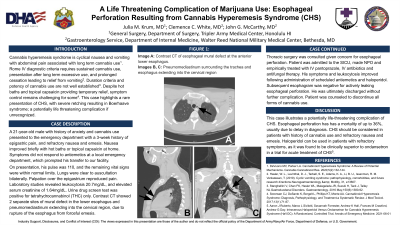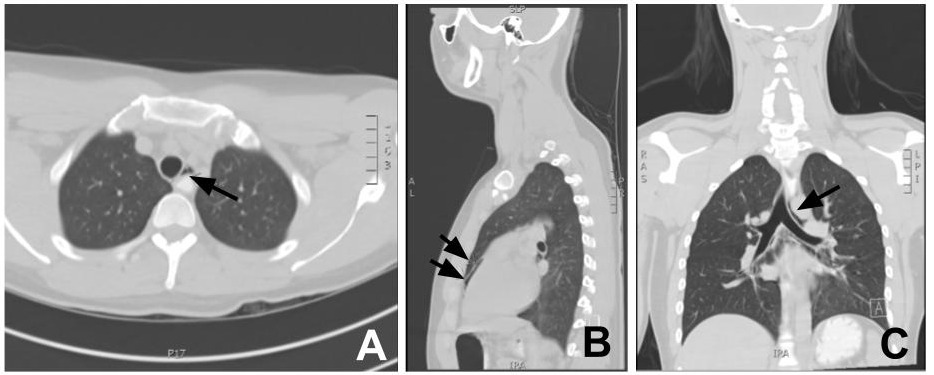Tuesday Poster Session
Category: Esophagus
P3311 - A Life-Threatening Complication of Marijuana Use: Esophageal Perforation Resulting From Cannabis Hyperemesis Syndrome (CHS)
Tuesday, October 24, 2023
10:30 AM - 4:00 PM PT
Location: Exhibit Hall

Has Audio
- JK
Julia Krum, MD
USUHS
Honolulu, HI
Presenting Author(s)
Julia Krum, MD1, Clemence C. White, DO2, John McCarthy, MD2
1USUHS, Honolulu, HI; 2Walter Reed National Military Medical Center, Bethesda, MD
Introduction: Cannabis hyperemesis syndrome (CHS) is cyclical nausea and vomiting with abdominal pain associated with long term cannabis use1. Rome IV diagnostic criteria requires sustained cannabis use, presentation after long term excessive use, and prolonged cessation leading to relief from vomiting2. Duration criteria and potency of cannabis use are not well established3. Despite hot baths and topical capsaicin providing temporary relief for some4 , though, symptom control remains challenging. This case highlights a rare presentation of CHS, with severe retching resulting in Boerhaave syndrome; a potentially life-threatening complication if unrecognized.
Case Description/Methods: A 21-year-old male with history of anxiety and cannabis use presented to the emergency department with a 3-week history of epigastric pain, refractory bouts of nausea and emesis. Nausea improved briefly with hot baths or topical capsaicin at home. Treatment did not respond to antiemetics at local emergency department, which prompted his transfer to our facility.
On presentation, his pulse was 110, and the remaining vital signs were within normal limits. Lungs were clear to auscultation bilaterally. Palpation over the epigastrium reproduced pain. Laboratory study revealed leukocytosis 20.7mg/dL, and elevated serum creatinine of 1.64mg/dL. Urine drug screen test was positive for tetrahydrocannabinol (THC) only. Contrast CT showed 2 separate sites of mural defect in the lower esophagus and pneumomediastinum extending into the cervical region, a result of effort rupture of the esophagus.
Thoracic surgery was consulted given concern for esophageal perforation. Patient was admitted to the SICU, made NPO and empirically treated with IV pantoprazole, IV antibiotics and antifungal therapy. His symptoms improved following administration of scheduled antiemetics and haloperidol. Leukocytosis resolved. Subsequent esophagram was negative for actively leaking esophageal perforation. He was ultimately discharged without further complication. Patient was counseled to discontinue all forms of cannabis use.
Discussion: This case illustrates a potentially life-threatening complication of CHS. Esophageal perforation, which has a mortality of up to 36%, usually due to delay in diagnosis. CHS should be considered in patients with history of cannabis use and refractory nausea and emesis. Haloperidol can be used in patients with refractory symptoms, as it was found to be clinically superior to ondansetron in a trial for acute treatment of CHS5.

Disclosures:
Julia Krum, MD1, Clemence C. White, DO2, John McCarthy, MD2. P3311 - A Life-Threatening Complication of Marijuana Use: Esophageal Perforation Resulting From Cannabis Hyperemesis Syndrome (CHS), ACG 2023 Annual Scientific Meeting Abstracts. Vancouver, BC, Canada: American College of Gastroenterology.
1USUHS, Honolulu, HI; 2Walter Reed National Military Medical Center, Bethesda, MD
Introduction: Cannabis hyperemesis syndrome (CHS) is cyclical nausea and vomiting with abdominal pain associated with long term cannabis use1. Rome IV diagnostic criteria requires sustained cannabis use, presentation after long term excessive use, and prolonged cessation leading to relief from vomiting2. Duration criteria and potency of cannabis use are not well established3. Despite hot baths and topical capsaicin providing temporary relief for some4 , though, symptom control remains challenging. This case highlights a rare presentation of CHS, with severe retching resulting in Boerhaave syndrome; a potentially life-threatening complication if unrecognized.
Case Description/Methods: A 21-year-old male with history of anxiety and cannabis use presented to the emergency department with a 3-week history of epigastric pain, refractory bouts of nausea and emesis. Nausea improved briefly with hot baths or topical capsaicin at home. Treatment did not respond to antiemetics at local emergency department, which prompted his transfer to our facility.
On presentation, his pulse was 110, and the remaining vital signs were within normal limits. Lungs were clear to auscultation bilaterally. Palpation over the epigastrium reproduced pain. Laboratory study revealed leukocytosis 20.7mg/dL, and elevated serum creatinine of 1.64mg/dL. Urine drug screen test was positive for tetrahydrocannabinol (THC) only. Contrast CT showed 2 separate sites of mural defect in the lower esophagus and pneumomediastinum extending into the cervical region, a result of effort rupture of the esophagus.
Thoracic surgery was consulted given concern for esophageal perforation. Patient was admitted to the SICU, made NPO and empirically treated with IV pantoprazole, IV antibiotics and antifungal therapy. His symptoms improved following administration of scheduled antiemetics and haloperidol. Leukocytosis resolved. Subsequent esophagram was negative for actively leaking esophageal perforation. He was ultimately discharged without further complication. Patient was counseled to discontinue all forms of cannabis use.
Discussion: This case illustrates a potentially life-threatening complication of CHS. Esophageal perforation, which has a mortality of up to 36%, usually due to delay in diagnosis. CHS should be considered in patients with history of cannabis use and refractory nausea and emesis. Haloperidol can be used in patients with refractory symptoms, as it was found to be clinically superior to ondansetron in a trial for acute treatment of CHS5.

Figure: Image A: Contrast CT of esophageal mural defect at the anterior lower esophagus. Images B, C: Pneumomediastinum surrounding the trachea and esophagus extending into the cervical region
Disclosures:
Julia Krum indicated no relevant financial relationships.
Clemence White indicated no relevant financial relationships.
John McCarthy indicated no relevant financial relationships.
Julia Krum, MD1, Clemence C. White, DO2, John McCarthy, MD2. P3311 - A Life-Threatening Complication of Marijuana Use: Esophageal Perforation Resulting From Cannabis Hyperemesis Syndrome (CHS), ACG 2023 Annual Scientific Meeting Abstracts. Vancouver, BC, Canada: American College of Gastroenterology.
